|
|


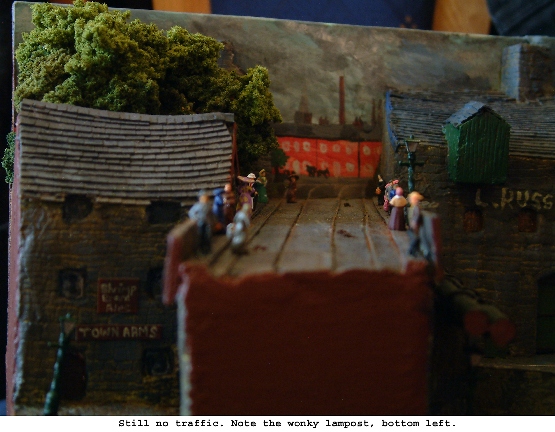

Finished overpass. No traffic yet, must be Sunday. |
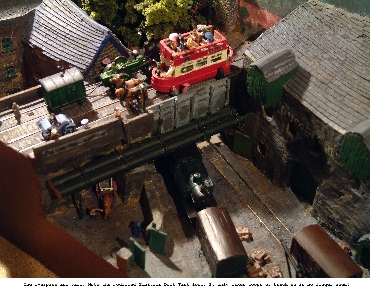
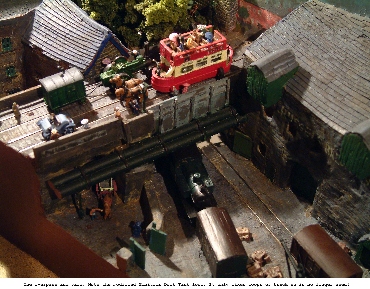
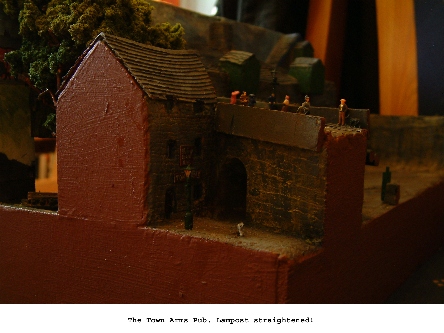
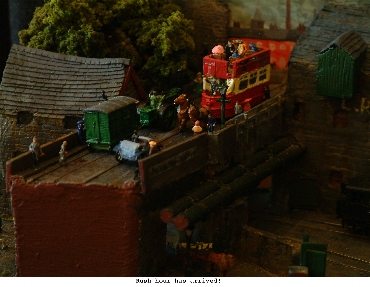
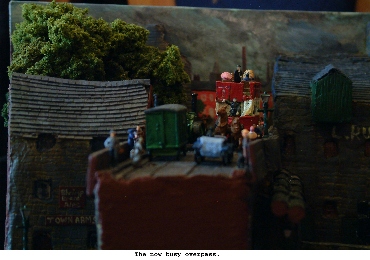

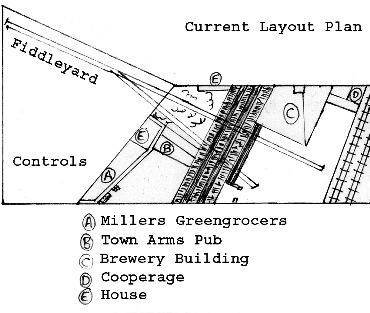
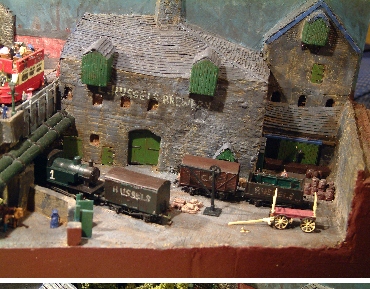
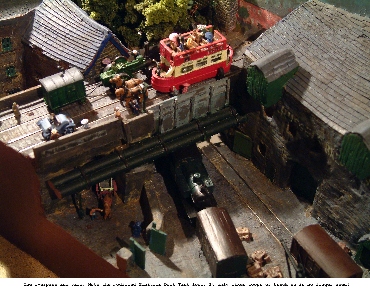
To make the gas pipes seen opposite, glue thin strips of plastic onto 1/4" wooden dowel. |
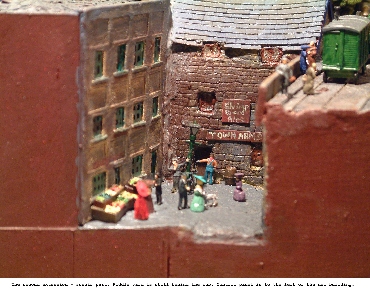
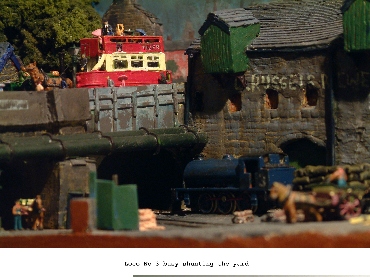
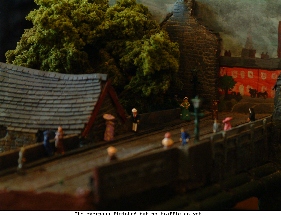
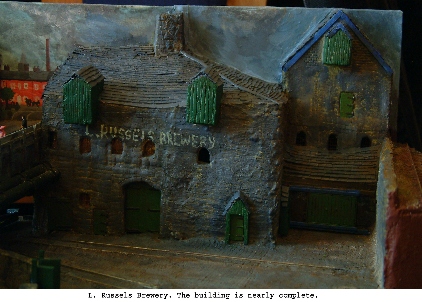
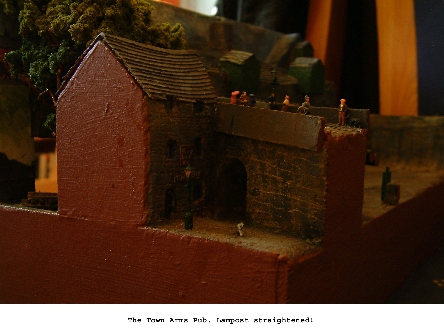

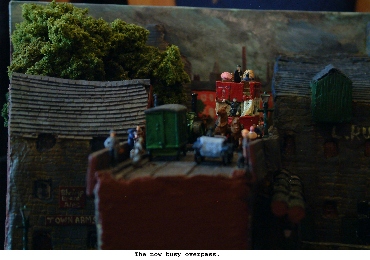
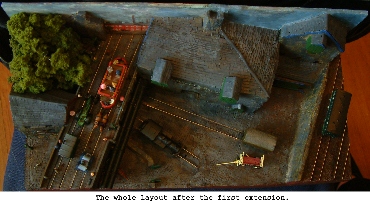
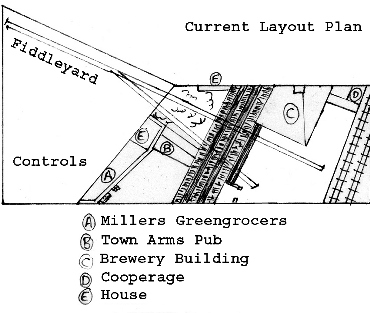
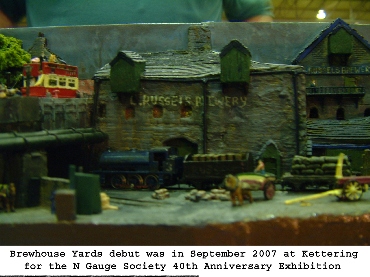
Modelling olden days in N gauge. |
History... Brewhouse Yard is one of those little rail served yards that appear from nowhere from underneath the arches in many towns and cities across the country. It's actually the end of a goods only branch line running from the nearby station to serve various industries. It serves, as the name suggests, a brewery. Only a small brewery, but a brewery none-the-less! |
When did this all happen? Fed up of extra transport costs, the local businessmen got together in 1869 to promote a railway of their own. Land was soon purchased and agreements made with the local railway company. |
The railway was completed in April 1872. Modest facilities were provided at each of the industries, usually just a single short siding. It is now summer 1906, big hats are the fashion and business is good. |
Reality... Of course, none of this actually happened. Brewhouse Yard exists purely as a figment of my imagination, although there is a street where I grew up of that name. I've always liked those little yards that you often see from the train window, wondering if they were once rail served. |
Industrial railways are also an interest of mine, so I thought I'd put the two together. There are a few links to where I grew up like brand/business names and the tramcar livery. |
The model... Started in October 2005, it has, taken nearly two years to reach the stage that you seebefore you! But of course the big question is: "Why model the 'olden days' in 'N' gauge?" The answer is that I like the Edwardian period and I hadn't modelled it in 'N' gauge before. |
In fact I havent seen it modelled in 'N' gauge before so I figured it would be a challenge. I thought it would be more challenging to make the layout as small as possible! |
Track & Baseboards I drew the original layout out, full size, on an A5 sheet of paper. I built it a little bigger, then added a bit to enclose the yard. I later added the fiddle yard end, eventually making it the 55 cm x 29 cm (21.5" x 11.25") version that you can see. |
A plywood box type construction was used originally using 5mm plywood, the fiddle yard end being made from plastic sheet to keep the weight down. |
If you havent already, you will notice changes in the pictures as you scroll down |
Track-work, working and non-working, is a mixture of both Peco code 80 & code 55 flexi track. The track consists of one point making two sidings so it is not too complicated. I did find at Brewhouse Yards debut exhibition, (The N Gauge Society's 40th Anniversary show at Kettering), that this combination played up a little so all the track is due to be re-laid with just code 55. All of the track is in filled with either clay or plaster and then the yard surface scribed in by hand. The tramway bridge track used the same method. The railway track has every other sleeper removed to give it a turn-of-the-century look so often seen in old photographs. |
The picture on the left shows the current amount of scenery on the new extension! |
Electrics Despite its small size and simplicity in track plan, there are still miles of wiring underneath the baseboard. This is mainly due to the electromagnets for the proposed automatic uncoupling in the future. Otherwise its two wires to the track. Control is by an old ECM compspeed that I've had for years. |
To make the fruit & veg stall on the left I made small boxes from plastic strip. These were then painted in various shades of brown and were filled with 'Liquid Lead', (small leads balls), which was then painted fruity colours! |
Rolling Stock Rolling stock consists of three vans, one round ended open and two flat wagons. There are two steam engines. These are, or should I say were, a repainted Farish J94 and a modified Minitrix dock tank. (I rounded off the square firebox, not an easy task!) |
The dock tank, like several of my aging locos, only likes continuous run layouts now so it has been replaced with a Dapol M7 in LSWR livery and is therefore authentic for the period modelled. I imagine that most people who own one of these can't claim that! |
Scenics There are just under fifty figures populating the layout. They are mainly by Presier, Peco, Model Power, SAF and Merten and have been converted to Edwardian dress by addition of model filler and plastic discs for hats. I found that Model Power steam era people are very useful as are Preiser brides. I never dreamt that I would be researching women's fashion to build a model railway! |
M7 on hire arrives for duty on Brewhouse Yard |
Edwardian Women: use a hole punch to make the disc for a hat. Use model filler to add length to dresses. |
All of the road vehicles are by Fleetline or Shire Scenes. Even the horse drawn tram, which started off as an electric one! The exception is the horseless carriage, or car, as we call them now. This is scratch built and based on an 1899 Opel but with equal size wheels whereas the prototype has smaller front wheels. It looks over-scale, but cars that were around then were huge compared to today's miniscule offerings! |
Another thing I had to figure out was how to model dung. Yes, dung. If you have horse drawn transport on the street you have dung left behind! The only exception to this seems to be in the last few years when they have to wear a nappy. Pre-grouping layouts in England are popular in the larger scales but you rarely see any dung modelled. |
Buildings are made mainly from plaster with stonework scribed in, the railway embankment and tramway bridge were made the same way. The only building that doesn't use this method is the greengrocers on the other side of the tramway bridge. I built this one up from layers of stiff paper and card. All the roof tiles are made of paper glued on in strips or individually and then painted. |
Everything is weathered as back then everything was dirty as it's a city, pristine doesn't exist! Any greenery is by Woodland Scenics, including the tree which is a dried grape stalk with clumped foliage glued on. Uncoupling at the moment is by GBS (God's Big Stick) but will be replaced by an automatic uncoupling system. |
The Future... Future plans for Brewhouse Yard include moving the control panel from the end of the layout to the back. This would not only make operating easier but would free up space for more scenery. Track to be relaid in code 55 and the short siding extended. I'm also going to add a dummy wagon turntable on a siding that will come out of the brewery and cross both the sidings. I've already got figures and road vehicles for this. More round ended wagons to be made as well. |